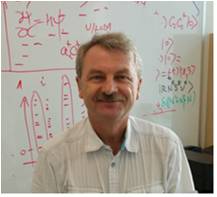报告时间:6月17日(星期一)10:00
报告地点:科技创新大楼C501室
报 告 人:Pawel Hawrylak 教授
邀请人:Mustafa Eginligil 教授
报告题目:Designing materials at the nanoscale
Abstract
We describe challenges and opportunities in condensed matter and materials physics applied to information and communication, lighting and energy technologies. We show how materials designed at the nanoscale address some of these challenges. These include quantum circuits based on electron spin[1], synthetic quantum systems hosting macroscopic quantum states[2], quantum dots in topological insulators[3], semiconductor nanocrystals[4], graphene quantum dots[5,6] and 2D materials for valley polarized electron gas[7] and laser cooling[8].
1) C-Y. Hsieh, et al., Rep. Prog. Phys.75, 114501 (2012).
2) Blazej Jaworowski et al.,NatureScientific Reports 7, 5529 (2017).
3) M. Korkusinski et al.,NatureScientific Reports4, 4903(2014).
4) Fengjia Fan, et. al. Nature 544,75 (2017).
5) D.Guclu,et. al. ”Graphene Quantum Dots”, Springer-Verlag (2014).
6) Y. Saleem, et. al., Journal of Physics: Condensed Matter 31 (30), 305503 (2019).
7) T. Scrace, et al.,NatureNanotechnology10, 603 (2015) .
8) J. Jadczak, et al. Nature Communications: DOI/10.1038/s41467-018-07994 (2019).
Biography

Dr. Pawel Hawrylak received PhD in Condensed Matter Theory from the University of Kentucky in 1984, did postdoctoral research at Brown University, and joined the National Research Council of Canada (NRC) in 1987 where he became Principal Research Officer and Leader of the Quantum Theory Group (QT-IMS) in 2001. Since 2014 he is a Professor of Physics and University Research Chair in Quantum Theory of Materials, Nanostructures and Devices at the University of Ottawa (http://mysite.science.uottawa.ca/phawrylak/index.html). His scientific interests cover theoretical and computational design of low-dimensional and nanostructured materials, theory of light-matter interaction at the nanoscale (nanophotonics) and spin properties of correlated electrons in semiconductor and graphene nanostructures (nano-spintronics and carbononics). Among Dr.Hawrylak’s contributions are theory of excitonic artificial atoms in self-assembled quantum dots, basis for quantum dot lasers, theory and demonstration of single spin transistors, basis for electron spin based quantum circuits, and development of carbononics, graphene based electronics, photonics and spintronics. Dr. Hawrylak co-authored two books and ~300 publications and reviews in condensed matter physics and nanoscience. Dr.Hawrylak’s contributions were recognized with ,e.g., Fellowship of the American Physical Society (1996), Humboldt Research Prize (1999), the CAP Brockhouse Medal (2002) ,“Professor Titular of Physical Sciences”, President of Poland (2005), Fellow of the Royal Society of Canada (2006), Fellow of the Canadian Institute for Advanced Research (2006), Honorary Professor, Wroclaw University of Technology(2010), Doctor Honoris Causa, University of Crete (2014) and Queen Elisabeth Diamond Jubilee Medal, Government of Canada (2013). Dr. Hawrylak served as Vice-Chair (2008-2011) of International Union of Pure and Applied Physics (IUPAP) Commission on Semiconductors and on the European Research Council Panel on Condensed Matter Physics PE3 (2012-2019). He serves as Associate Editor of Solid State Communications and on over 50 advisory and program committees of international conferences. Dr.Hawrylak was invited to speak at over 200 international conferences and physics colloquia and seminars at institutions in North and South America, Europe and Asia.
